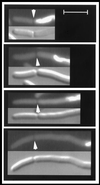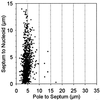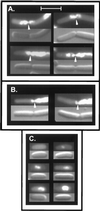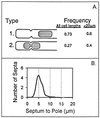Nucleoid-independent identification of cell division sites in Escherichia coli
- PMID: 10074085
- PMCID: PMC93591
- DOI: 10.1128/JB.181.6.1900-1905.1999
Nucleoid-independent identification of cell division sites in Escherichia coli
Abstract
The mechanism used by Escherichia coli to determine the correct site for cell division is unknown. In this report, we have attempted to distinguish between a model in which septal position is determined by the position of the nucleoids and a model in which septal position is predetermined by a mechanism that does not involve nucleoid position. To do this, filaments with extended nucleoid-free regions adjacent to the cell poles were produced by simultaneous inactivation of cell division and DNA replication. The positions of septa that formed within the nucleoid-free zones after division was allowed to resume were then analyzed. The results showed that septa were formed at a uniform distance from cell poles when division was restored, with no relation to the distance from the nearest nucleoid. In some cells, septa were formed directly over nucleoids. These results are inconsistent with models that invoke nucleoid positioning as the mechanism for determining the site of division site formation.
Figures







Similar articles
-
Influence of the nucleoid on placement of FtsZ and MinE rings in Escherichia coli.J Bacteriol. 2001 Feb;183(4):1413-22. doi: 10.1128/JB.183.4.1413-1422.2001. J Bacteriol. 2001. PMID: 11157955 Free PMC article.
-
FtsZ ring clusters in min and partition mutants: role of both the Min system and the nucleoid in regulating FtsZ ring localization.Mol Microbiol. 1999 Apr;32(2):315-26. doi: 10.1046/j.1365-2958.1999.01351.x. Mol Microbiol. 1999. PMID: 10231488
-
FtsZ rings in mukB mutants with or without the Min system.Biochimie. 2001 Jan;83(1):125-9. doi: 10.1016/s0300-9084(00)01222-0. Biochimie. 2001. PMID: 11254986
-
Spatial control of bacterial division-site placement.Nat Rev Microbiol. 2005 Dec;3(12):959-68. doi: 10.1038/nrmicro1290. Nat Rev Microbiol. 2005. PMID: 16322744 Review.
-
Bacterial cell division: regulating Z-ring formation.Mol Microbiol. 2001 May;40(4):795-803. doi: 10.1046/j.1365-2958.2001.02370.x. Mol Microbiol. 2001. PMID: 11401687 Review.
Cited by
-
Hunting the Cell Cycle Snark.Life (Basel). 2024 Sep 24;14(10):1213. doi: 10.3390/life14101213. Life (Basel). 2024. PMID: 39459514 Free PMC article.
-
Chromosome segregation and cell division defects in recBC sbcBC ruvC mutants of Escherichia coli.J Bacteriol. 1999 Oct;181(19):6179-83. doi: 10.1128/JB.181.19.6179-6183.1999. J Bacteriol. 1999. PMID: 10498734 Free PMC article.
-
Influence of the nucleoid on placement of FtsZ and MinE rings in Escherichia coli.J Bacteriol. 2001 Feb;183(4):1413-22. doi: 10.1128/JB.183.4.1413-1422.2001. J Bacteriol. 2001. PMID: 11157955 Free PMC article.
-
MinDE-dependent pole-to-pole oscillation of division inhibitor MinC in Escherichia coli.J Bacteriol. 1999 Oct;181(20):6419-24. doi: 10.1128/JB.181.20.6419-6424.1999. J Bacteriol. 1999. PMID: 10515933 Free PMC article.
-
Spatial coordination between chromosomes and cell division proteins in Escherichia coli.Front Microbiol. 2015 Apr 14;6:306. doi: 10.3389/fmicb.2015.00306. eCollection 2015. Front Microbiol. 2015. PMID: 25926826 Free PMC article.
References
-
- Åkerlund T, Bernander R, Nordström K. Cell division in Escherichia coli minB mutants. Mol Microbiol. 1992;6:2073–2083. - PubMed
-
- Cook W, Rothfield L. Early stages in development of the E. coli division site. Mol Microbiol. 1994;14:485–495. - PubMed
-
- Cook W, Rothfield L I. Development of potential division sites in FtsA− filaments of E. coli. Mol Microbiol. 1994;14:497–503. - PubMed
Publication types
MeSH terms
Substances
Grants and funding
LinkOut - more resources
Full Text Sources

